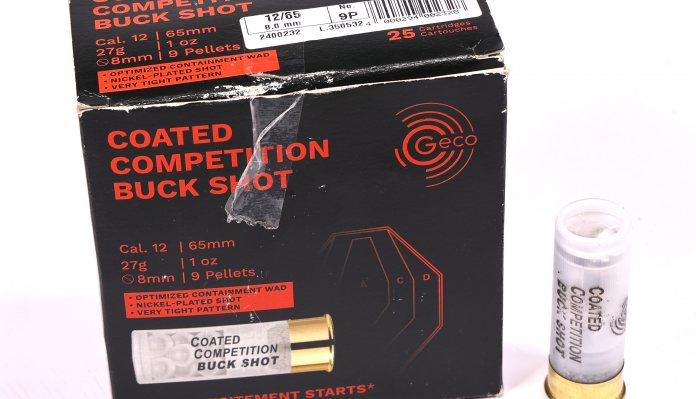Geco Competition Buck Shot
-
0
 Comments
Comments
- Last updated: 09/07/2023

Geco is a very familiar name to us Brits, and the company was established 136 years ago, in 1887 (blimey!). Founded by Gustav Genschow, his business began as a wholesaler of firearms and ammunition, then quickly expanded. Today, Geco ammunition is manufactured under tight quality controls at sites in Germany, Switzerland, Sweden, and Hungary.
A while back, I tested some Geco Competition Slug Red and was seriously impressed by their performance. Now, it’s time for the equally well-made, Geco Coated Competition Buck Shot, which is primarily aimed at the competition shotgun marketplace, meaning the cartridge on test is ideal for the Buck Shot Stages at IPSC competitions. However, I was interested to see how they would perform out in the field, where a couple of buck shot cartridges in the pocket can come in handy when rough shooting.
They are a good price at £80 per 100, as you will probably get through tonnes of them during a competition. I bought mine from Norman Clark Gunsmiths in Rugby.
These cartridges come in 12-gauge only and have a 65mm case length (2 ½”). They feature a clear plastic casing, and all of the cartridge details are labelled in black on the outside. It’s a ribbed case and very uniform in its construction. When measured with my run-out tool, they came up as very concentric, too. You have a high, brass head that shows a pronounced rim for positive extraction from the gun’s chamber, and they are marked proudly with ‘Germany’ and ‘Geco’ on the base.
The closure up top is your typical rolled-top design. This not only provides weather resistance but also helps to maintain correct back pressure for a smooth ignition. These Geco rounds also feature a clear plastic topper to keep the shot from falling out.
Inside, there is 21.2-grains of flaked powder that is a light green colour. It is almost identically sized and sits directly under the wad. The head area of the cartridge is very uniform too, and allows Geco’s premium primer to ignite efficiently, ensuring all of the powder content is burnt. This helps to achieve a very uniform and consistent initial pressure spike that ultimately drives the shot charge forward in one smooth and controlled motion. This is good for ballistics, and your shoulder.
The wad is a one-piece, plastic design with a cupped rear area to seal the bore. There is then a concertina-type section to absorb some of the powder ignition thrust, reducing the chance of damaging any of the pellets. This wad totally encloses the shot with the forward cup section to avoid bore contact. This is helpful when it comes to tight bores or chokes. The wad also features small slits and vents down the upper edge, so that its forward momentum is retarded as it exits the barrel, allowing the buckshot to exit freely.
The actual payload consists of nine pellets, with each one showing a diameter of 8mm and a good spherical form (some flattened edges). The total load weighs 27-grams, so a standard shotgun loading.
What is special about these beautifully formed buck shot, is that the lead core is coated with a nickel outer shell. This not only helps to protect the user from lead exposure but also means good ballistic performance. This ultimately translates to very tight patterns down range, which is exactly what the competition shooter or foxer wants.
I set up the pattern board at 30 yards and grabbed my faithful old Mossberg Duck Commander, which usually wears the excellent A-Tec A12 silencer. I removed this for the test, as I wanted to use flush fit ¼ and ½ chokes instead. I shot without a red dot or scope fitted, but in retrospect, using one would have been a good idea, as these rounds are well-suited to sights.
Once I started shooting, the patterns were tight and definitely higher than normal. With the full choke fitted and the pattern board at 30 yards, the pellets impacted some 12” higher than my central point of aim! However, it was a tight pattern that measured 7” wide, 4” high, and consisted of eight hits (one pellet went over the top). Excellent!
Taking the point of impact into account, I switched to the ¼ choke and aimed 10” below the centre, giving me a centralised pattern. It was wider, obviously, and all nine pellets hit the board. The pattern measured 18” wide and 10” high.
So, a respectable pattern for the ¼ choke, making it, or a ½ choke, a good choice, depending on your requirements in the field. Whereas the full choke would certainly help when it comes to competition use. Anyway, I can now support Geco’s claims that the nickel-plated shot reduces flyers and produces tighter patterns.
In use, the amount of recoil generated was no more than a standard 1oz load, even though you think the gun is going to kick more. It is also worth mentioning that the shorter 65mm case length allows for a higher capacity in tubular magazines, where legal to do so.
Reliability in the Mossberg pump was unsurprisingly 100%, and the same can be said for the Beretta A400 semi-auto. I plan on trying some of these cartridges in some tactical shotguns from Huglu or Derya. These are hopefully coming soon.
As with all Geco ammunition, you get good value for money and a quality product. The manufacturing is top-notch and the nickel-plated buck shot is perfectly formed, contributing to the excellent patterns down range.
